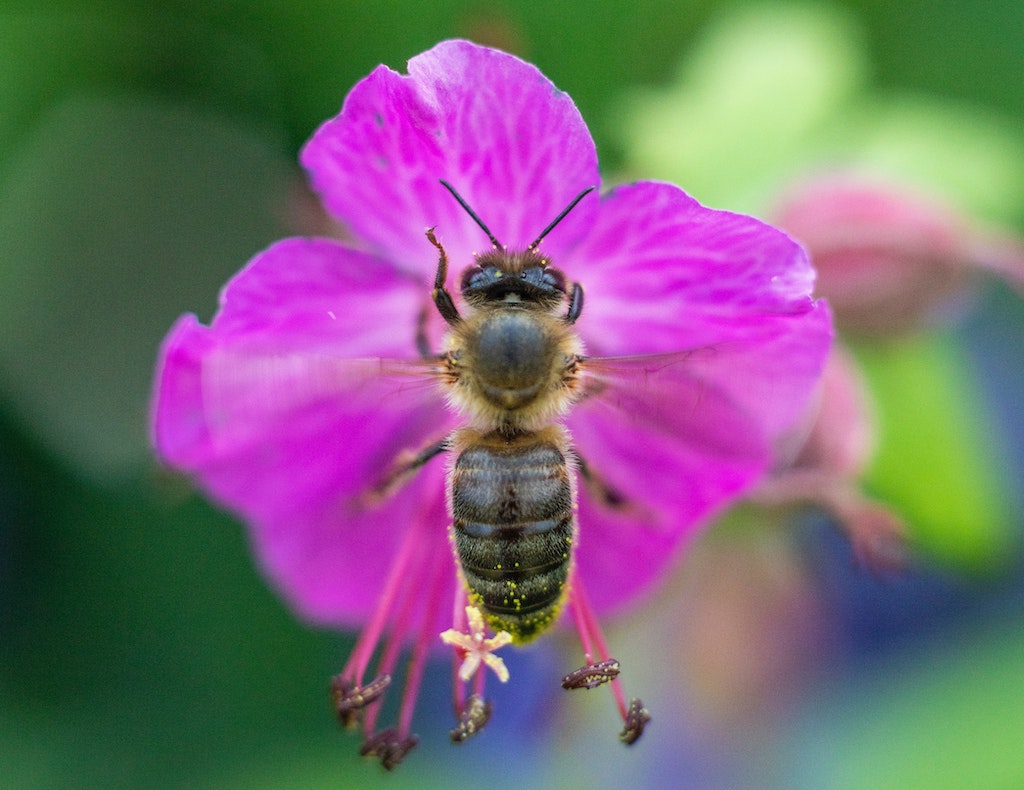Every action that defines the life of a bee would not be possible without their antennae. The two long, wavy sensory organs perched on bees’ heads give them powers straight from a science fiction film. The basic senses include smell, hearing, and taste- as well as humidity, carbon dioxide, gravity, and wind speed detection. Who knew that two humble antennae were capable of so much?

Structure of Antennae
All bees have antennae with the same basic structure to collect information. There are four muscles at the base of the antenna which control its movement. From the bottom of the bee’s head extends the scape – joined to the pedicel with a joint that allows it to move in different directions. Connected to the pedicel is the flagellum, the part of the antenna with all the receptors. Male bees have 11 subsegments on their flagellum, and females have 10. Not only do antennae vary based on a bee’s gender, but it also varies based on the type of bee: eusocial and solitary bees. Eusocial bees live in dense colonies with specialized roles to play, so their antennae have more functions to help them communicate with their colony members, perceive pheromones, forage for nectar, etc.
Scents and Pheromone Perception
Scent Reception – Bees find flowers based on the nectar’s sugar content and how far the source is. Foragers want the sweetest nectar to make honey. The more sugar that nectar has, the more nutritious it is (this health advice only applies to bees!). But how do they determine the highest sugar levels in the most efficient way? Workers don’t go around to every type of flower and take a sample. They can smell traces of sweetness, even midflight. Or rather, the odor receptors on their antennae detect sugar, even while they’re flying. The ability to smell sugar also relates to why bees have two antennae. It’s not just for aesthetic purposes though bees would look rather odd with only one. With two flexible antennae, bees can detect at least two different paths of nectar, and they can compare which one is stronger and adjust their flight path accordingly.
Scent reception also helps bees perform another task: removing the dead bodies of their fallen kin. Bees rarely die in the hive because they fly away when they sense their demise or die on foraging trips. However, when that doesn’t happen, undertakers must carry the dead about 100 meters away from the hive because corpses can spread infection and deadly diseases. In a swarm of around 80,000 bees, it would be impossible to simply spot an unmoving bee. Dead bees release a particular scent, so only a remarkable sense of smell, courtesy of the antennae, let undertaker bees find corpses and carry them away.
Pheromone Communication – When a queen bee is ready to mate, she releases a pheromone to attract drone bees. Drones, the male bees, have longer antennae and around 300,000 chemoreceptors, 100 times more than females, so that they can sense and mate with a queen mid-flight.
Back at the hive, the queen emits a unique pheromone. This pheromone controls the behavior of the rest of the colony. Pheromones are hormones that act outside of an animal’s body. For example, if there are not enough foragers, worker bees at their nursing stage perceive pheromones that tell them to transition to foragers. The queen can also release pheromones that serve as warning signs to peril. When a queen goes missing or dies, the rest of the hive notices the absence of her chemical, and it harms the colony unless a new queen arrives. Without the queen chemical to regulate the workflow, workers will forage less, and they might even start producing drones.
Queen bee pheromones are not the only ones that bees can detect. Bees guarding the hive can tell if a bee trying to enter is from their hive from their “smell.” In addition, when bees sting, they release a chemical that summons other bees because they receive a signal that the hive might be in danger. Antennae allow bees to communicate in ways different than detecting pheromones. Functions on the antennae also enable bees to pass information through touch and hearing.
Touch
Bees have extraordinarily developed eyes that allow them to see the ultraviolet spectrum. However, these organs are rendered useless when bees have to perform tasks inside the hive, like telling others where the best patch of flowers are, transferring honey, and building honeycomb. Why? Because the inside of a beehive is completely dark, and eyes don’t work without light. Thus bees rely on the sensitive hairs on their antennae to communicate. Bees dance to relay information, so touching another bee with an antenna helps them understand it.
Additionally, workers make honey by passing nectar mouth to mouth until it reaches a comb. To accurately transfer the nectar, bees must be properly aligned so they use their tactile senses to signal if they are ready to begin the process. Also, bees can make these hexagonal cells incredibly consistent because their antennae can detect the thickness, shape, and depth of the cells and walls.
Other senses
Bees don’t have ears, but they can hear. A sensor at the base of the antenna can detect the vibrations of sound waves and wind, allowing them to understand other bees dancing and determine how fast they are flying. Different sensors give bees a grasp of carbon dioxide levels and temperature. If there is too much carbon dioxide, bees fan their wings to ventilate, and if it is too hot, bees use water to cool down their hives. Also, a sudden, sharp increase in carbon dioxide signals to bees that a breathing animal might pose a threat.

To conclude, bees’ antennae can do just about anything, from giving bees remarkable ways of communicating to detecting carbon dioxide levels. Isn’t it wonderful how something so simple looking, like antennae, is plays a vital role in a bee’s life?
